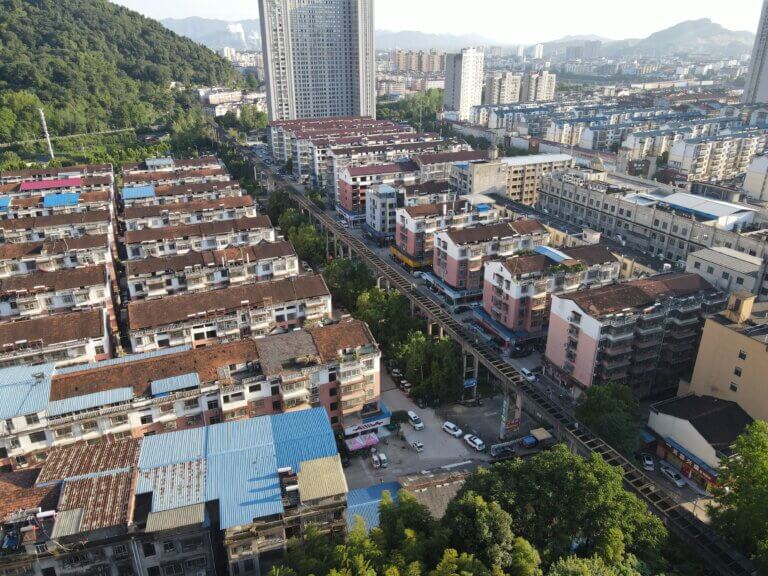On September 13, 2021, following the kick-off and interim workshops, the final workshop on the study “Research on the Promotion and Adoption of New Energy Vehicles (NEVs) in the Field of Urban Logistics Distribution” took place. The workshop was jointly organized by the Deutsche Gesellschaft für Internationale Zusammenarbeit (GIZ) and the Transport Planning and Research Institute (TPRI) of the Ministry of Transport of the People’s Republic of China (MoT). Various policymakers, scholars, and technical experts participated in the workshop and shared their reflections on the status quo and their perspectives on the future development of the urban freight and delivery sector in China, as well as concrete suggestions for the final study result.

Presentation of the study results by TPRI. Picture Source: GIZ
China has already become the world’s largest country in the production and sales of New Energy Logistics Vehicles (NELVs). Despite a sales drop due to the gradual phase out of purchase subsidies since 2018, the number of NELVs in China has reached 412,000 in 2019, accounting for 10.8% of the country’s total NEV stocks (see Figure 1). As there are regional in terms of economic development and climate conditions, the promotion of NELVs has both similarities and differences across regions and cities in China. To gather first-hand data on the overall implementation of the Green Urban Freight Pilot Program,[1] field investigations and interviews were conducted in six pilot cities: Yinchuan, Zhengzhou, Chengdu, Shenzhen, Foshan, and Zhangjiakou.

Figure 1. Sales and stocks of NELVs between 2015 and 2019 in China
The study has identified stakeholder’s interests in participation, best practices, lessons learnt, and the key remaining challenges for the NEV promotion and application in the urban delivery sector in China. It has projected different NELV application scenarios and proposed policy suggestions for future development.
Stakeholder Analysis
The stakeholder analysis has categorized and examined three groups in the development of NELV application in urban delivery, namely: governmental authorities, market players, and other stakeholders including academia and industrial associations. Governmental authorities are ministries, departments, and commissions at national and local level. Market players are companies along the supply chain of the NELV industry from production to operation, as well as maintenance. Other stakeholders include research institutions and universities active in Research and Development (R&D) in related fields. Among these stakeholder groups, national-level governmental departments, production and sales enterprises, and research institutions have shown highly positive attitudes[2] towards the promotion of NELVs.
Table 1. Analysis of Key Stakeholders

Challenges for NELV promotion
The range of measures for NELV promotion in the pilot cities vary, but mainly include fiscal support for NELVs and their supporting facilities, dedicated entry permits for city centers, prioritized road access, and exclusive parking for loading/unloading. The study has identified the critical challenges in the development of NELVs in China, such as insufficient right of way policies, low cost-effectiveness, a lack of sufficient charging facilities, inadequate standards and norms for NELV production and operation, as well as inadequate after-sales services.
However, different cities have encountered different challenges according to their respective levels of development. Take Shenzhen and Yinchuan for instance. Shenzhen’s NELV market has been relatively well established, making the sales and operation of NELVs more effective, but vehicle safety regulations and after-sales services are two remaining impediments for further development. In Yinchuan, which has a much colder climate than Shenzhen, an insufficient travel range in the winter remains a considerable challenge. Further issues for NELV development in Yinchuan include a lack of exclusive right of way privileges, meaning NELVs have the same status as conventional internal combustion engine vehicles, and an incomplete after-sales support system.
NELV development trends & application scenarios
The study has provided a forecast for NELV development, according to which the proportion of NEVs in China’s newly added urban logistics vehicles is expected to reach 30%-40% by 2025, and the total share of NELVs in the urban delivery sector is expected to reach 15%-20%.
In the future, battery electric logistics vehicles (BELVs) will mainly be applied in the delivery of common goods in urban areas of mild temperatures, with a daily operation mileage of up to 200 km in cities without comprehensive charging networks, and up to 400 km in cities with well-established charging facility infrastructures.
Policy Suggestions
Based on the provided expert recommendations, the policy suggestions will be finalized, with a focus on categorizing and concretizing measures covering the whole industrial chain of NELVs from production and sales to application and after-sale services. The policy suggestions include:
- Large-scale reduction of the production costs,
- Further exploration of innovative business models,
- Implementation of road use privileges for NELVs,
- Acceleration of infrastructure construction,
- Establishment and improvement of related norms and standards, and
- Completion of after-sale services.
More concrete policy suggestions will be presented in the final research report. The outcome of the study will be a systematic guide for the future promotion and application of NEVs in the urban delivery sector in China with concrete and direct reference to the MoT and other national and sub-national policymakers, urban logistics companies, and further relevant stakeholders such as local transport bureaus, operators of the charging infrastructure, as well as vehicle maintenance and recycling companies. The study will also provide best practice examples and lessons learnt for cities in and outside of China looking to promote NEVs in the urban delivery sector.
The final research report will be published by the end of this year. For more information, please contact Dr Xuan LING (transition-china@giz.de), Senior Advisor for freight and logistics in the Sino-German Cooperation on Low Carbon Transport (CLCT) project.
[1] To further drive the development of NEVs in urban delivery, China’s Ministry of Transport (MoT), Ministry of Public Security (MPS), and Ministry of Commerce (MofCom) jointly launched the Green Urban Freight Pilot Program. A total of 46 cities in two batches (22 cities in December 2017 and 24 cities in September 2019) were selected for the program.
[2] In this context motivation and willingness of stakeholders to adopt NELVs





